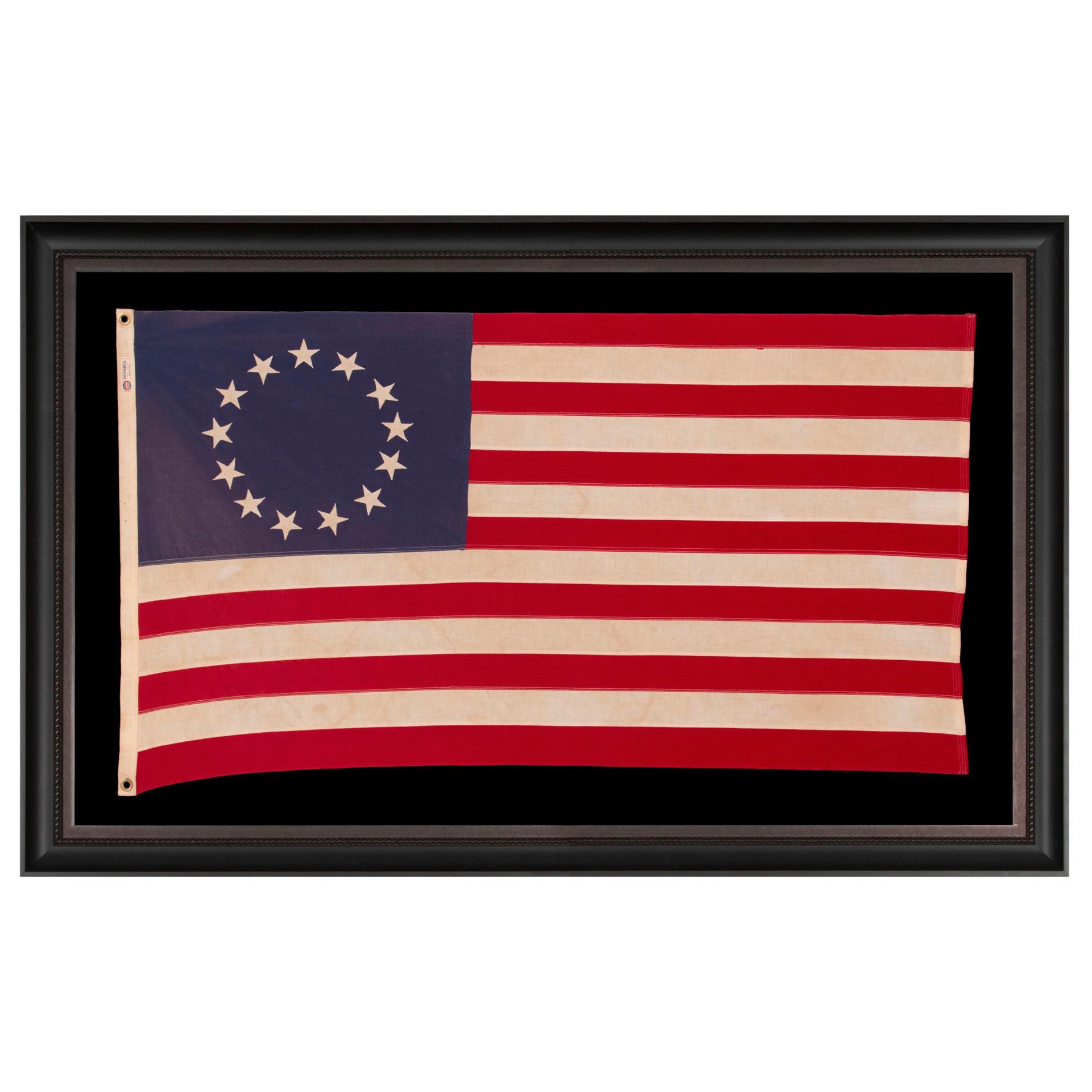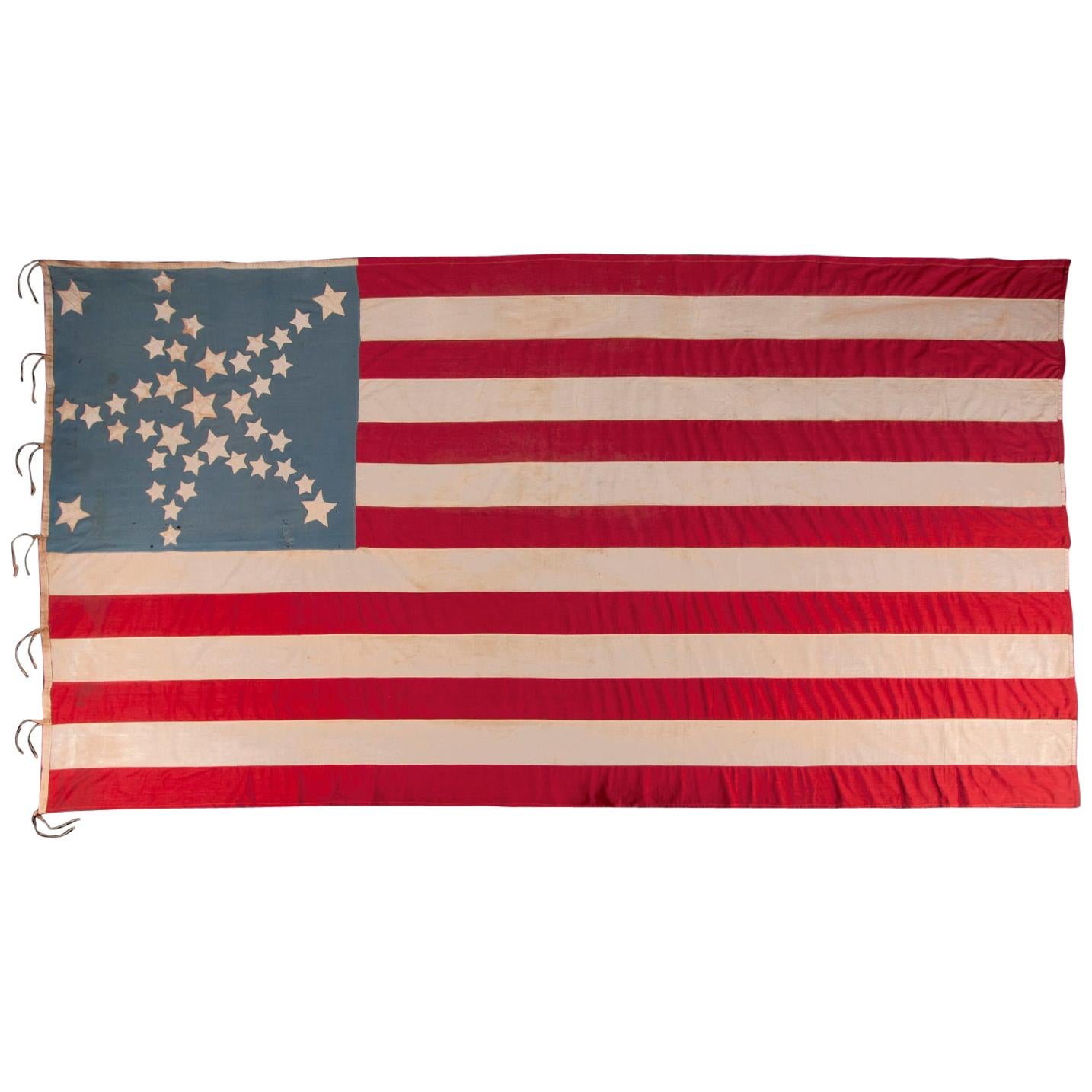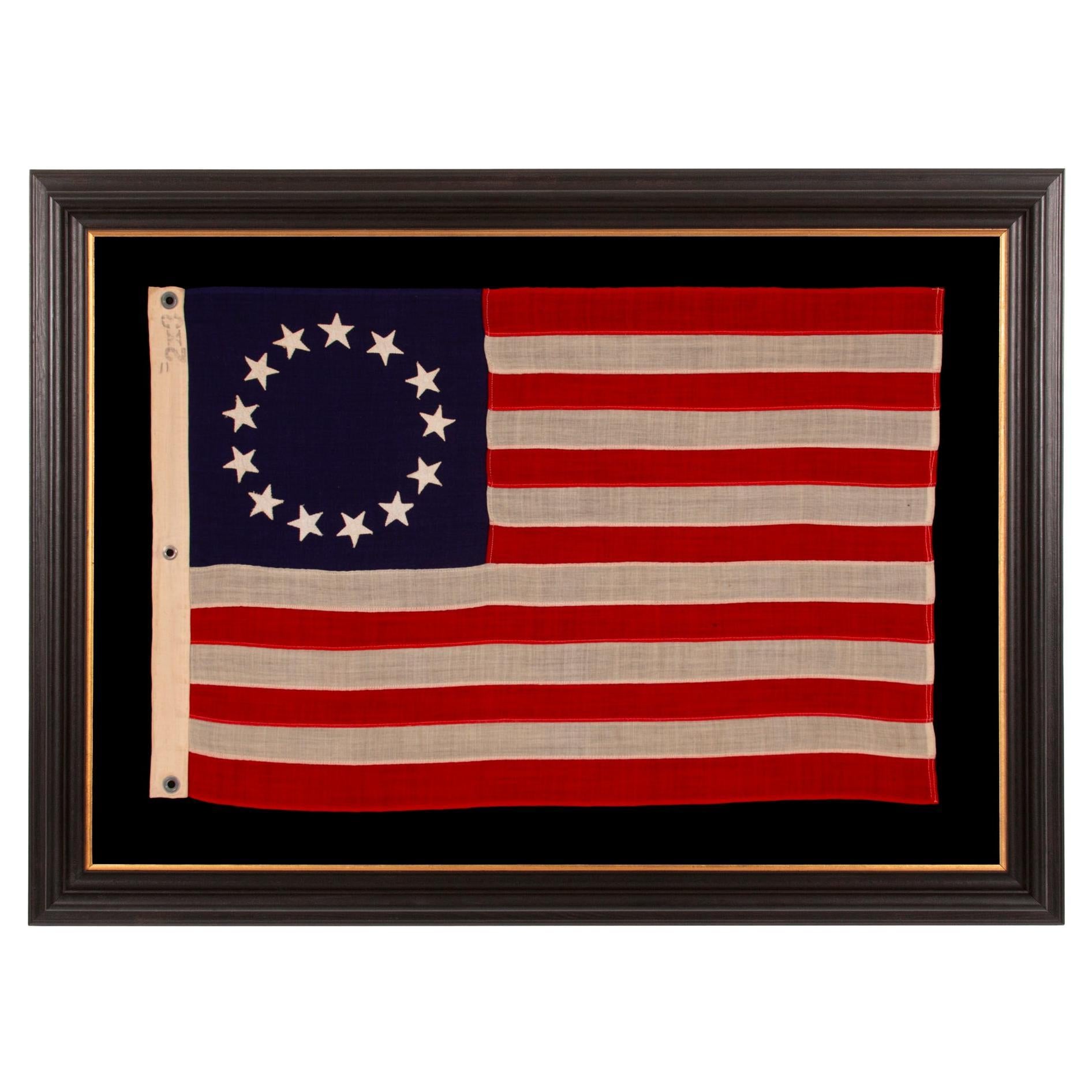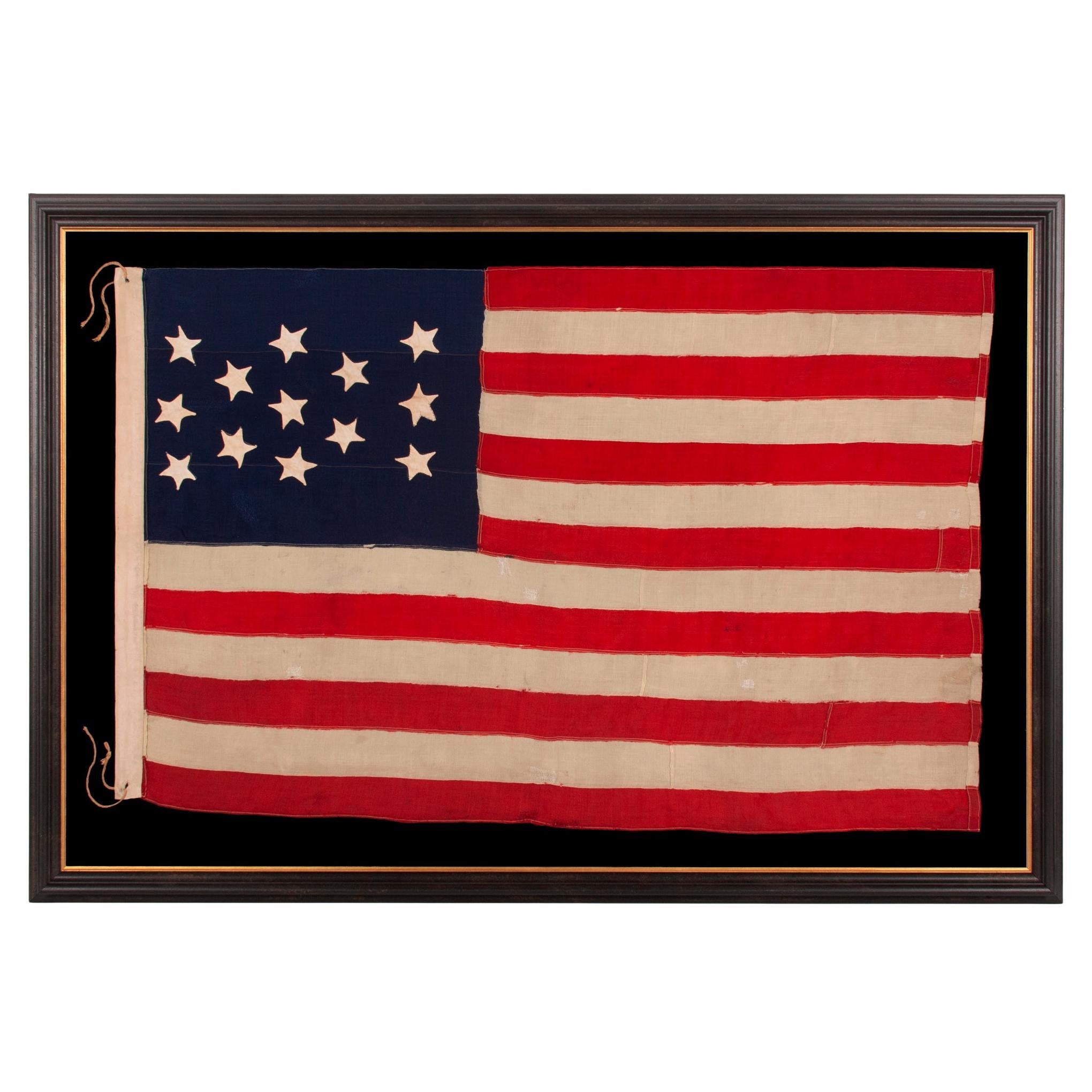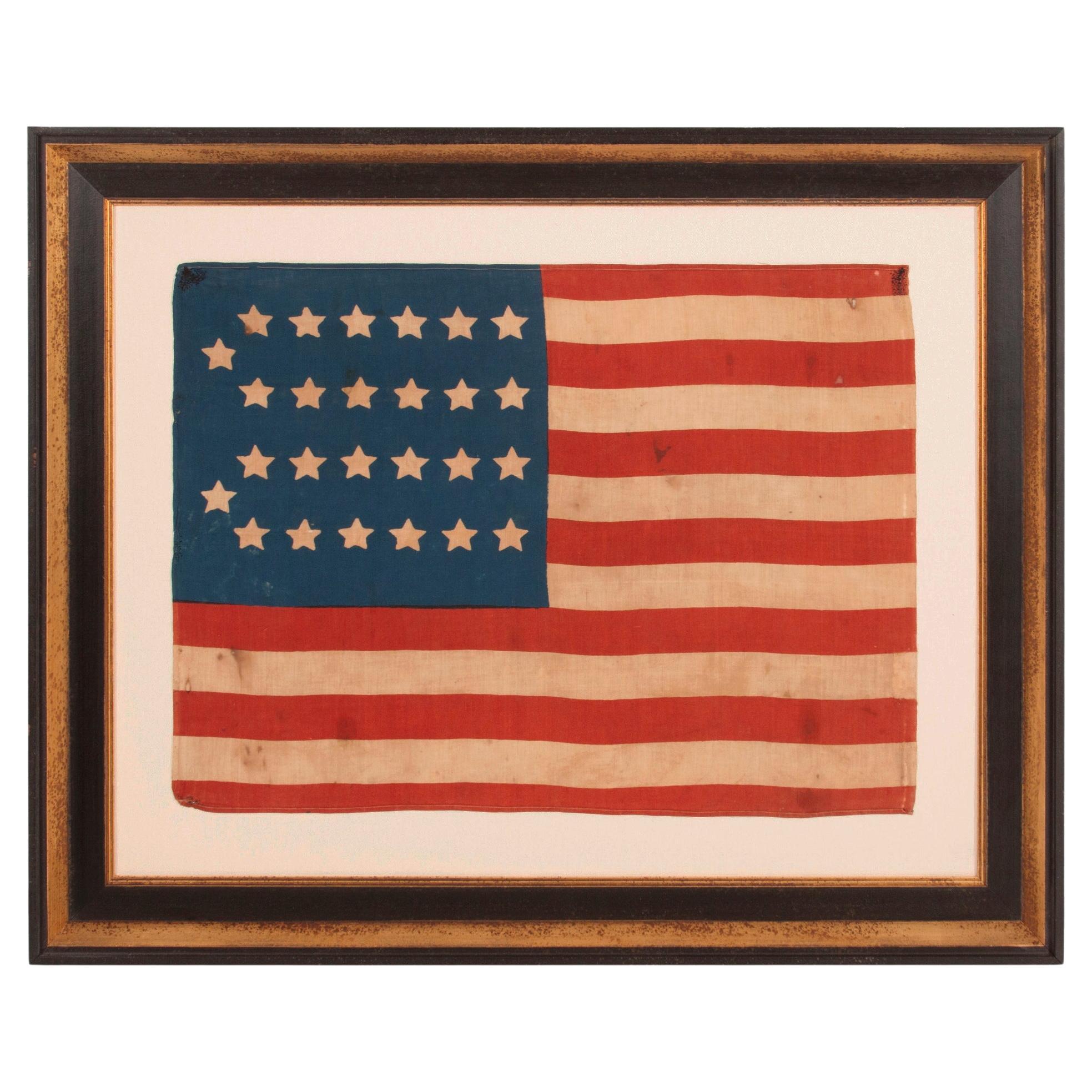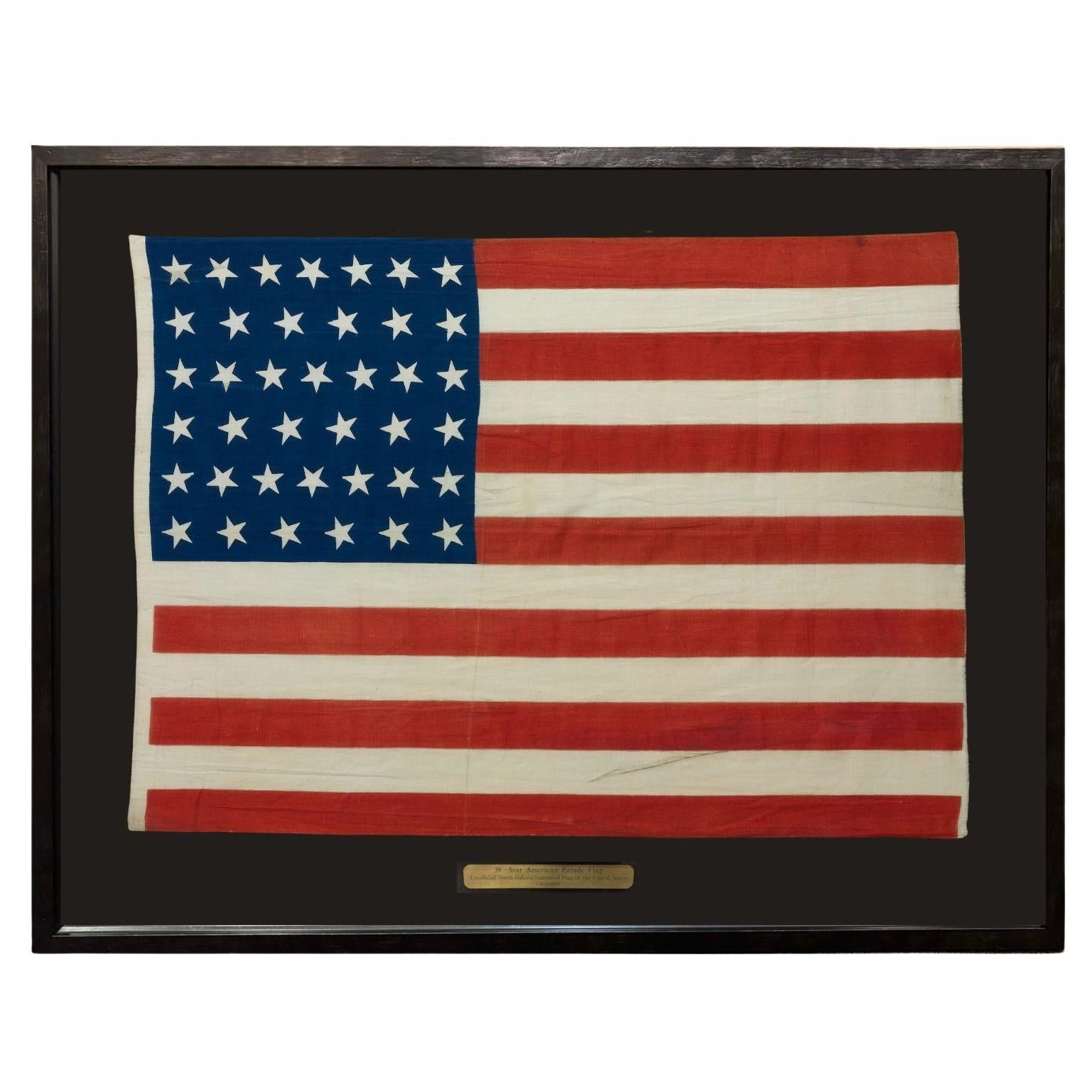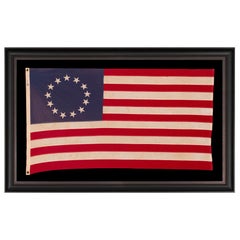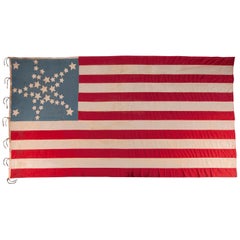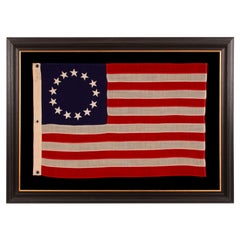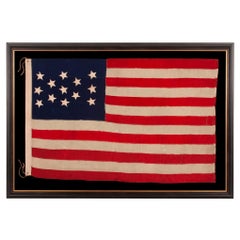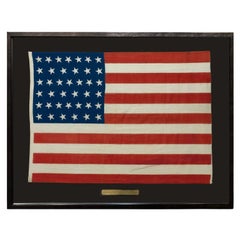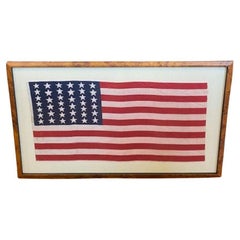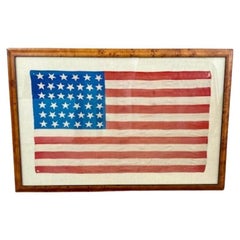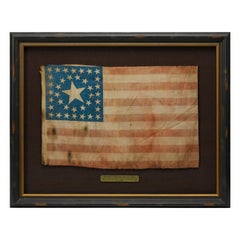Items Similar to Antique American Flag w/ 13 Stars in the Betsy Ross Design & 45 Stars on Reverse
Want more images or videos?
Request additional images or videos from the seller
1 of 13
Antique American Flag w/ 13 Stars in the Betsy Ross Design & 45 Stars on Reverse
Price Upon Request
Price Upon Request
Price Upon Request
Price Upon Request
Price Upon Request
Price Upon Request
Price Upon Request
Price Upon Request
Price Upon Request
Price Upon Request
Shipping
Retrieving quote...The 1stDibs Promise:
Authenticity Guarantee,
Money-Back Guarantee,
24-Hour Cancellation
About the Item
13 STARS IN THE BETSY ROSS PATTERN, WITH 45 STARS ON THE REVERSE; ON AN ANTIQUE AMERICAN FLAG MADE AND SIGNED BY A PREVIOUSLY UNIDENTIFIED FLAG-MAKER, ANNIE MAC LACHLAN OF JERSEY CITY, NEW JERSEY, circa 1896-1908; A RARE AND INTERESTING EXAMPLE, IN A LARGE SCALE AMONG EARLY 13 STAR FLAGS IN THIS DESIGN
Highly unusual American national flag, with 13 stars on the obverse (front), arranged in the circular wreath pattern most often attributed to Betsy Ross, and 45 stars on the reverse, in staggered rows of 8-7-8-7-8-7.
Flags in the Betsy Ross design are widely admired, due to the longstanding popularity of the Ross family myth. While many Americans were taught in grammar school that it was her that made and designed our first flag, and that the stars appeared in this fashion, there is unfortunately no way to prove the claim. No colonial examples have survived with this pattern of stars. In fact, I have encountered just a couple of examples of Betsy Ross pattern flags which I can confidently date prior to the 1890's.
This particular flag has a black-inked stencil along the binding, near the top, that reads: “A. Mac. Lachlan Maker,” followed by “236 3rd St. Jersey City.” I have not before encountered this mark, or this name. And while I have not combed through the business directories for the city, I found no other references to anyone by this name associated with flag or sail making in the associated period. With the address and surname, however, I was able to identify the individual as Annie A. Mac Lachlan (b. 1851, d. ), who appears at this location in the 1900 U.S. Census, along with her husband, Charles Mac Lachlan (b. 1847), an express driver, and a 64-year-old boarder, Mary E. Humason. Annie did not list a profession and, though her birthplace is listed as New York, I have not yet been able to locate any other records about her whatsoever.
What is evident about Annie Mac Lachlan, is that this was by no means her first flag. Made in an explicit, professional manner, with all of the hallmarks of an experienced flag-maker, using materials and methods expected of the most advanced firms in the trade, I expect that Annie had been employed by a leading maker, such as Annin or the McFaddens in New York City, or Horstman Brothers in Philadelphia. Because she was born in New York, and because of the method in which the flag is made, I expect that she most likely worked for one Annin.
The count of 45 stars is original to the flag and this count was intended to be viewed on both sides. The stars are made of cotton, hand-sewn, and single-appliquéd. This means that they were applied to one side of the canton, then the blue fabric was cut from behind each star, folded over, and under-hemmed, so that one star could be viewed on both sides. I always find single-appliquéd stars more interesting, not only because they are evidence of a more difficult level of seam-work and stitching, but also because they are more visually intriguing. The two visible rows of hand-stitching emphasize their hand-sewn construction. While some flag enthusiasts have pointed to this as a means of conserving fabric, not having to cut and sew another star to the opposite side, others suggest that the real purpose was to make the flag lighter in weight. I believe it to have been a byproduct of both objectives. This method was pursued by Annin for some of its best flags, long after it had been abandoned by other makers. By the 1896-1908 period, however, when there were 45 states, Annie was obviously out on her own, and at 45-55 years of age, would have likely worked for Annin or a similar firm some years previous, when hand-sewn, single-appliquéd stars were more common. In addition, she probably did have the equipment necessary to machine-sew stars with a zigzag stitch. This was new technology in the 1890’s and likely deemed too expensive and unnecessary for what may have been a one or two-woman show, making flags in Annie’s home on 3rd Street.
The canton and stripes of the flag are made of wool bunting, joined by what was likely a treadle machine. There is a twill cotton binding along the hoist, with three brass grommets. The herringbone, twill tape ties, affixed at the top and bottom, are original to its period of use.
The flag’s 13, large stars are also made of cotton. These are appliquéd with lineal, treadle stitching to a second, wool bunting canton, which was then carefully appliquéd over the first, on the obverse, by hand-stitching. Because wool bunting has an open weave, which allowed water to pass through it more freely, the 45 stars are opaquely visible behind it. This makes for an interesting presentation and a unique object in my experience with early flags. Not instantaneously noticed, it is nonetheless readily visible after more than a casual glance, and more so once you know it is present. Because wool bunting was only used in the manufacture of flags and banners, and not easily acquired at a dry goods store that served the average public, and because the sewing is the sort I would expect from a professional flag-maker undertaking the task, I suspect that the work was done by Annie herself by special order. She may very well have had the 45 star flag on hand and added the 13 star canton by commission. This is precisely the era when the Betsy Ross pattern was gaining much visibility in nearby Philadelphia.
One of the interesting misconceptions about 13 star flags is that the Betsy Ross pattern, even if not the original design, must have been common in early America. Logic would suggest this, given the frequency with which it appears in modern times, but this isn’t actually the case. In fact, the pattern is seldom encountered anywhere until much later.
13 star flags have been continuously produced throughout our nation’s history for purposes both patriotic and utilitarian. This was the original number of stars on the American flag, representing the 13 colonies, so it was appropriate for any flag made in conjunction with celebrations or notions of American independence. 13 star flags were displayed at patriotic events, such as Lafayette’s final visit in 1825-26, the nation’s centennial anniversary in 1876, and celebrations of Independence Day. They were used by presidential candidates when campaigning for office and were carried by soldiers during the Mexican and Civil Wars to draw a parallel between the current and previous struggles for freedom.
13 star flags were flown by American ships both private and federal. The U.S. Navy used 13 stars on the ensigns made for small boats, because they wished the stars to be easily discerned at a distance. As the number of stars grew with the addition of new states, two circumstances occurred. One, it became more and more difficult to fit stars on a small flag, and two, it became more difficult to view them from afar as individual objects.
One of the best arguments against the Betsy Ross pattern having appeared on the original flag is illustrated by the fact that so many 13 star flags exist without it. If the Ross design was the original, it stands to reason that the pattern would have been reproduced with at least some degree of frequency. Most people are surprised to learn, however, that one will rarely encounter an American flag with the Betsy Ross pattern that was, with any degree of certainty, made before the 1890s. In fact, I have owned just two that I have claimed to pre-date the last decade of the 19th century, and know of just one other that shares this trait.
Research conducted by the National Museum of American History notes that the story of Betsy Ross making the very first American flag for General George Washington, in the company of George Ross and Robert Morris, entered into American consciousness about the time of the 1876 centennial. The tale was immensely popular among an American public eager for stories about the Revolution and its heroes. The first documentation of it appeared shortly beforehand, in 1870, in a paper written by Betsy’s grandson, William Canby, for the Pennsylvania Historical Society. At the time, Canby made no mention of how the flag was designed, save for the fact that it had 5-pointed stars, per his grandmother’s suggestion. Because no earlier documentation supports the story, most flag scholars feel it was a grand hoax, fabricated by Canby for his own interests. Nothing survives in the collective writings of the three men, for example, nor in records of their words and deeds, which are fairly extensive. As with most things, reality is perhaps somewhere in the middle ground, with some of the details based on fact and some on fiction, made up, misinterpreted, or imagined from family accounts.
The first time that a star configuration gets attached to the Ross story appears to have occurred during the last decade of the 19th century. In 1892, Charles Weisgerber painted a nine-by-twelve-foot rendition of the fabled meeting between Betsy and George Washington, in which there is a flag with a circular wreath. Shortly afterwards, in 1898, Betsy’s granddaughter and great-granddaughter began to make flags in the East Wing of Independence Hall in Philadelphia, selling them to tourists while disseminating the family folk tale. In that same year, Weisgerber and a “group of concerned citizens” sought to preserve Betsy’s former Philadelphia residence at 239 Arch Street, where she lived at the time the flag would have been sewed. Weisgerber moved his family into the house and immediately opened to the public the room in which Betsy was said to have worked her magic. Ten-cent memberships were sold to fund renovations and donors received a small calendar, to which a cotton 13 star Betsy Ross pattern parade flag was affixed. The effects of these events caused the Ross legend to stick and the story, with the corresponding flag design, has appeared ever since in more places than one could ever hope to count.
All this having been said, flags in the Betsy Ross pattern that survive from the 1890’s through the opening quarter of the 20th century are few and far between, especially in a large scale, like this example. I have owned just a tiny handful of them over the years. The combination of this fact, and the flag’s wonderful presentation, plus it’s unusual complement of 45 stars on the reverse, and the circumstance of this being the work of an identified, but previously unknown maker, combine to result in a wonderful example of the period in which it was made.
Mounting: The flag was mounted and framed within our own conservation department, which is led by expert staff. We take great care in the mounting and preservation of flags and have framed thousands of examples.
The flag has been hand-stitched to 100% silk organza for support throughout. It was then hand-stitched to a background of 100% cotton twill, black in color, that was washed and treated for colorfastness. The mount was placed in a black-painted, hand-gilded and distressed, Italian molding. The glazing is U.V. protective acrylic (Plexiglas).
Condition: There are very minor holes in the first red stripe, accompanied by even more minor instances elsewhere, throughout. There is minor water staining in the 2nd, 8th, 10th, 11th, and 12th stripes, and very minor soiling in the stars. There is modest to moderate staining along the binding, accompanied by a scattering of small dark spots of staining along the leading edge in several places. There is a small tear in the binding, to the hoist end side of the center grommet. Many of my clients prefer early flags to show their age and history of use.
- Dimensions:Height: 65.75 in (167.01 cm)Width: 105.25 in (267.34 cm)Depth: 2.5 in (6.35 cm)
- Style:Other (Of the Period)
- Materials and Techniques:
- Place of Origin:
- Period:
- Date of Manufacture:1896-1907
- Condition:Wear consistent with age and use.
- Seller Location:York County, PA
- Reference Number:Seller: 13j-15701stDibs: LU849738162152
About the Seller
5.0
Recognized Seller
These prestigious sellers are industry leaders and represent the highest echelon for item quality and design.
Established in 1991
1stDibs seller since 2008
70 sales on 1stDibs
Typical response time: 1 to 2 days
- ShippingRetrieving quote...Shipping from: York County, PA
- Return Policy
Authenticity Guarantee
In the unlikely event there’s an issue with an item’s authenticity, contact us within 1 year for a full refund. DetailsMoney-Back Guarantee
If your item is not as described, is damaged in transit, or does not arrive, contact us within 7 days for a full refund. Details24-Hour Cancellation
You have a 24-hour grace period in which to reconsider your purchase, with no questions asked.Vetted Professional Sellers
Our world-class sellers must adhere to strict standards for service and quality, maintaining the integrity of our listings.Price-Match Guarantee
If you find that a seller listed the same item for a lower price elsewhere, we’ll match it.Trusted Global Delivery
Our best-in-class carrier network provides specialized shipping options worldwide, including custom delivery.More From This Seller
View All13 Star, Betsy Ross Pattern Flag, Made by the Annin Company, ca 1955-1965
Located in York County, PA
13 STARS IN THE BETSY ROSS PATTERN, ON A VINTAGE AMERICAN FLAG, MADE BY THE ANNIN COMPANY OF NEW YORK & NEW JERSEY, circa 1955 - 1965
13 star American national flag, made entirely of cotton by the Annin Company of New York & New Jersey, in the period between approximately 1955-1965. The stars are arranged in the circular wreath pattern most often associated with Betsy Ross. Flags in this design are widely admired, due to the longstanding popularity of the Ross family myth. While many Americans were taught in grammar school that this was what our first flag looked like, there is, unfortunately, no way to substantiate the claim, and no colonial flags...
Category
Late 20th Century American Political and Patriotic Memorabilia
Materials
Cotton
34 Star American flag, Updated to 39 Stars, with Stars in a Great Star Pattern
Located in York County, PA
34 STARS IN A WHIMSICAL RENDITION OF THE GREAT STAR PATTERN, ON A CIVIL WAR PERIOD FLAG WITH A CORNFLOWER BLUE CANTON, UPDATED TO 39 STARS IN 1876
34 star American national flag with additional stars added and one of the most stunning graphic designs I have ever seen in early flag-making. The original pattern was comprised of a circle of 5 large stars, and triangular arms made of smaller stars. These are noticeable pointy and bent like the arms of a starfish. Made of cotton, the stars are hand-sewn and double-appliquéd to a fantastic, cornflower blue canton, a color common to Civil War uniforms...
Category
Antique 1870s American Political and Patriotic Memorabilia
Materials
Cotton
Price Upon Request
Free Shipping
13 Stars in a Betsy Ross Pattern, ca 1910-1926
Located in York County, PA
13 STARS IN THE BETSY ROSS PATTERN ON A SMALL-SCALE ANTIQUE AMERICAN FLAG MADE SOMETIME BETWEEN APPROXIMATELY 1910 AND THE 1926 SESQUICENTENNIAL OF AMERICAN INDEPENDENCE
13 star fla...
Category
Mid-20th Century Political and Patriotic Memorabilia
Materials
Wool
Price Upon Request
13 Star Antique American Flag with a Narrow Star Presentation, ca 1876
Located in York County, PA
13 STAR ANTIQUE AMERICAN FLAG WITH HAND-SEWN STARS IN AN EXTREMELY NARROW PRESENTATION OF A 3-2-3-2-3 ARRANGEMENT ON A CANTON THAT DOESN’T FOLLOW SUIT, LEAVING WIDE EXPANSES OF BLUE ...
Category
Antique 1870s American Political and Patriotic Memorabilia
Materials
Wool
Price Upon Request
26 Star Antique American Flag, with 11 Stripes, Michigan Statehood, ca 1837-1846
Located in York County, PA
26 STAR ANTIQUE AMERICAN PARADE FLAG WITH 11 STRIPES AND IT’S CANTON RESTING ON THE “WAR STRIPE.” THE EARLIEST KNOWN STAR COUNT FOR PRINTED EXAMPLES, 1837-1846, MICHIGAN STATEHOOD
2...
Category
Antique Mid-19th Century American Political and Patriotic Memorabilia
Materials
Cotton
38 Star American Parade Flags with Stars in a Great Star Pattern
Located in York County, PA
38 STAR AMERICAN PARADE FLAG WITH A RARE AND BEAUTIFUL VARIATION OF THE “GREAT STAR” OR “GREAT FLOWER” PATTERN, 4 LARGE CORNER STARS, & AN ODD OUTLIER, 1876-1889, COLORADO STATEHOOD,...
Category
Antique Late 19th Century American Political and Patriotic Memorabilia
Materials
Silk
Price Upon Request
You May Also Like
39-Star Antique American Flag with 'Whimsical' Star Pattern, 1889
Located in Colorado Springs, CO
This is a 39-star unofficial American flag, handmade and printed on cotton. The flag dates to 1889 and has a unique history, thanks to its rare star-count.
The flag’s canton is prin...
Category
Antique 1880s American Political and Patriotic Memorabilia
Materials
Cotton
19th Century 39 Star American Flag, circa 1889
Located in Nantucket, MA
19th Century 39 Star American Flag, circa 1889, a printed linen ensign with 39 stars arranged in a wavy star pattern, with stripes in a very unus...
Category
Antique 1880s American Federal Political and Patriotic Memorabilia
Materials
Linen
19th Century American 39 Star Flag, circa 1889
Located in Nantucket, MA
19th Century American 39 Star Flag, circa 1889, a period printed silk parade flag with a wavy pattern of dancing stars. This was never an official flag of the United States but was m...
Category
Antique 1880s American Federal Political and Patriotic Memorabilia
Materials
Silk
38-Star Antique American Flag with Unique Canton, circa 1876-1890
Located in Colorado Springs, CO
This is a striking 38-star American flag. The flag dates to 1876-1890, when Colorado (represented by the large star in the center of the flag’s canton) joined the Union as the 38th s...
Category
Antique Late 19th Century American Political and Patriotic Memorabilia
Materials
Muslin
31-Star Printed American Flag, Celebrating California Statehood, Circa 1850
Located in Colorado Springs, CO
This is a rare 31-star medallion printed American flag, celebrating the addition of California to the Union. The flag is printed on silk and has a spectacular “Great Star” canton pat...
Category
Antique 1850s American Political and Patriotic Memorabilia
Materials
Silk
Centennial Celebration "1776-1876" American Flag Banner
Located in Colorado Springs, CO
Presented is a rare Centennial patriotic flag banner, dating to 1876. The flag’s brilliant blue canton is spectacular, with 81 five-pointed, rayed stars, arranged to read “1776” and “1876.” The flag’s design is completed with thirteen alternating red and white stripes. The flag is a three-piece, treadle-sewn sewn construction, printed on a thin wool and cotton blend. Along the edge, there is a narrow, treadle-sewn sleeve made of cotton tape.
In the lead up to the nation’s Centennial in 1876, flag makers and individuals looked to the past for designs to produce as part of the country’s many celebrations. Popular interpretation of the stars and stripes undoubtedly reached its climax of variety and originality at the time of our Nation’s first Centennial. Since no design restrictions were placed on flagmaker’s imaginations and no strict distinctions were drawn between official and unofficial star counts, it is no surprise that, on the occasion of the Centennial, creativity in flag design was not the exception, but the rule.
The cantons from this period presented an array of geometric abstractions. Great star patterns, referred to as the “starry flower of Liberty” by Oliver Wendell Holmes, that were popular from 1818 and on, resurfaced in Centennial flags...
Category
Antique 1870s American Political and Patriotic Memorabilia
Materials
Wool, Cotton
More Ways To Browse
Civil War Antiques
Antique American Flags
American Trade Signs
Framed American Flags
19th Century American Flag
American Flag Cotton
Antique Wool Machine
Small American Flag
Antique American Flag Framed
Independence Hall
Navy Flags
Wool Combs Used
Gilded Age Antiques
General Store Sign
Old Canton
Folk Art Soldier
Wool Flag
Department Store Display
